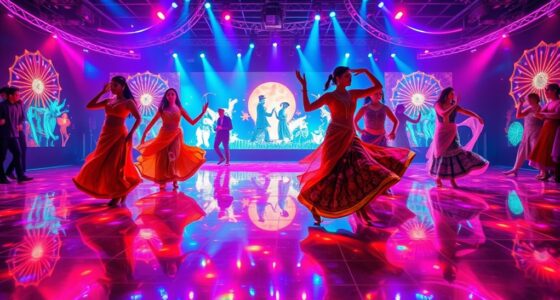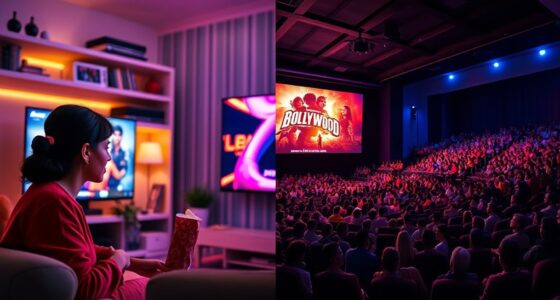While Bollywood is beginning to experiment with interactive storytelling, full viewer-driven narratives like those in some international films are still rare. Technological barriers like cost, infrastructure, and audience readiness slow adoption. However, with advancements in AI, VR, and digital platforms, Bollywood might soon embrace more immersive, choice-based experiences. If you want to understand how these innovations could transform Indian cinema, there’s more to explore below.
Key Takeaways
- Bollywood is gradually exploring interactive storytelling through streaming platforms and experimental projects.
- Technological barriers and high production costs pose challenges to implementing branching narratives in India.
- Audience preferences favor traditional, linear films, but younger viewers show growing interest in interactive content.
- Partnerships with global tech firms and infrastructure upgrades support the development of interactive Bollywood films.
- Future trends suggest increasing adoption of AI, VR, and real-time technology to enable viewer-chosen endings.
The Rise of Interactive Storytelling in Global Cinema

The rise of interactive storytelling in global cinema reflects how technology is transforming traditional viewing experiences. You now have more ways to influence what you watch, making movies more personalized and immersive. The industry is projected to hit $34 billion in revenue by 2025, with animated films like Ne Zha 2 driving growth. Market data shows AI-generated movies are gaining popularity, expected to grow from $1.5 billion in 2024 to $12 billion by 2032, with a 35% CAGR. These innovations enable you to shape narratives in real-time, boosting engagement across entertainment, education, and marketing. As technology advances, studios are tapping into this trend to attract audiences who crave interactive, customized experiences, redefining how cinema connects with viewers worldwide. The integration of interactive content into films signifies a shift towards more dynamic and engaging viewing modalities, further blurring the line between passive and active entertainment. Moreover, understanding viewer engagement is crucial for creators aiming to develop compelling interactive narratives that resonate with diverse audiences. The increasing adoption of advanced technologies is also facilitating the development of more sophisticated and seamless interactive experiences. Additionally, emerging tools like AI-driven storytelling are opening new possibilities for personalized cinema experiences, making interactivity more accessible. Furthermore, these advancements are encouraging a new wave of creative innovation, inspiring filmmakers to experiment with novel storytelling techniques.
Bollywood’s Traditional Approach to Narrative Structures

You notice that Bollywood’s stories often follow a clear, linear path with set endings that audiences expect. These films prioritize cultural values and familiar narrative patterns, making them easy to follow and emotionally engaging. As a result, the storytelling tends to favor predictability over experimentation, reinforcing traditional storytelling norms. However, some filmmakers are beginning to experiment with narrative innovation, challenging these conventions and exploring new ways to engage viewers. This shift indicates a potential evolution in storytelling methods that could incorporate audience participation and more interactive elements in the future. Additionally, advances in voiceover techniques and multimedia integration could pave the way for more immersive and participatory cinematic experiences. Moreover, understanding the changing landscape of film technology can help filmmakers craft more dynamic and responsive storytelling formats.
Linear Storytelling Norms
Why do Bollywood films often follow a predictable pattern of storytelling? It’s rooted in traditional influences like epic and folk traditions, theatrical roots, and mythological genres that shape narrative structures. These stories emphasize emotion and spectacle over complex plots, making them more accessible and engaging. Repetitive scenarios, songs, and dance sequences have become staples, reinforcing audience expectations. Family tropes are used to explore social themes, while genre conventions guide story development. Audiences prefer films that offer escapism and emotional connections, often centered around cultural values. These norms create a familiar framework that resonates deeply with viewers, ensuring entertainment remains rooted in tradition. Additionally, the industry’s reliance on star power and formulaic scripts maintains audience loyalty, which discourages experimental storytelling approaches like interactive movies. Moreover, the influence of cultural heritage continues to shape narrative choices, emphasizing traditional storytelling elements over innovation. Furthermore, the industry often favors predictable plotlines that align with audience preferences, leaving little room for unconventional formats. The use of familiar storytelling techniques helps reinforce these patterns, making audiences feel comfortable and engaged with the content. Incorporating new storytelling techniques, such as interactive movies, could potentially revolutionize how stories are told in Bollywood, attracting a broader and more diverse audience. It would also benefit from integrating digital storytelling tools to create more immersive experiences for viewers.
Set Endings Dominance
Bollywood films traditionally follow set endings that reinforce familiar narrative patterns, creating a sense of closure that audiences expect. You’ll notice most movies follow a three-act structure, with a clear resolution that ties up loose ends. These stories often revolve around a heroic protagonist who overcomes obstacles, with a happy ending or moral lesson. Genre mixing—action, romance, comedy—adds to the predictability, as audiences anticipate familiar tropes. Musical numbers punctuate key moments, emphasizing spectacle and emotional payoffs. This approach aligns with commercial cinema conventions, designed to satisfy viewers’ desire for escapism and emotional catharsis. This adherence to traditional endings reflects Bollywood’s emphasis on audience satisfaction and cultural storytelling norms. Additionally, the reliance on predictable narrative patterns ensures the films resonate with cultural expectations and foster audience loyalty.
Cultural Narrative Preferences
How do traditional Indian storytelling methods shape Bollywood’s narrative structures? They favor episodic, additive storytelling rooted in oral tradition, making plots fragmented and non-linear. Flashbacks, time jumps, and repetition simplify complex stories for diverse audiences. Cultural storytelling techniques help convey complex themes subtly and effectively within these narratives. A rich tapestry of cultural references is woven into the storytelling, enhancing the depth and resonance of the narratives. Subplots and digressions, inspired by epics and folk tales, emphasize memory over causality, heightening emotional impact. Characters follow archetypes like heroes, heroines, villains, and sidekicks, reinforcing cultural values. Stories mirror mythology, folklore, and spiritual elements, emphasizing themes of duty, honor, and sacrifice. Visual metaphors, song sequences, and melodrama deepen emotional resonance. The production process, with multiple authors working independently, fosters thematic shifts and segmented narratives, aligning with audience expectations rooted in traditional storytelling. Additionally, the use of cultural symbolism helps convey complex themes subtly and effectively within these narratives. This storytelling style often prioritizes emotional engagement over strict narrative coherence, reinforcing cultural ideals and collective memory. Moreover, the reliance on episodic storytelling allows filmmakers to adapt and modify narratives to suit changing audience tastes and societal values.
Technological Barriers Hindering Interactive Films in India
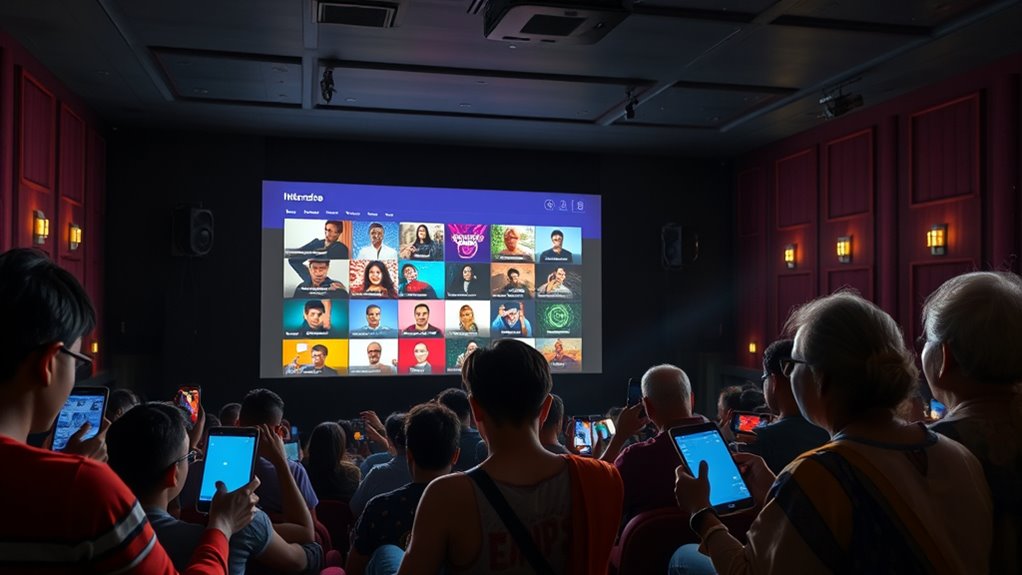
Technological barriers considerably hinder the growth of interactive films in India, primarily due to limited infrastructure and high production costs. Without widespread high-speed internet, seamless streaming of interactive content becomes challenging, restricting audience access. Creating these films also demands specialized, expensive equipment, making it difficult for local filmmakers to invest. The technical expertise needed to develop complex software and manage branching narratives is often lacking, especially in regions with limited resources. Additionally, the complexity of content creation requires advanced skills that are not yet widespread. The relatively limited market demand for interactive films further discourages investment, as the potential returns may not justify the high costs involved. These technological hurdles slow down the adoption and development of interactive movies within India’s evolving entertainment landscape. Limited infrastructure remains a significant obstacle, preventing the widespread rollout of interactive content across diverse regions, especially where broadband connectivity is unreliable. Moreover, the absence of a mature digital distribution ecosystem hampers the reach of such innovative content to a broader audience.
The Financial Implications of Producing Branching Narratives

Producing branching narratives can considerably boost your costs because you need multiple filming scenarios and more complex scripts. These additional elements increase production expenses and introduce revenue uncertainty, making it harder to predict returns. You’ll need to carefully weigh whether the potential gains outweigh these higher financial risks. Furthermore, the higher costs associated with branching narratives can strain budgets that are already tight, especially for regional film productions with lower overall budgets.
Production Cost Increase
Creating interactive movies considerably raises production costs due to the need for multiple storylines, which increases scriptwriting, development, and post-production expenses. You’ll need more time and resources to craft complex scripts, often requiring additional writers or specialists in interactive storytelling. Storyboarding and planning become more extensive, demanding multiple creative sessions and revisions. Development delays can push back production schedules, adding overhead costs. Post-production becomes more labor-intensive, as editing must accommodate various narrative paths, visual effects, and sound design for different endings. Encoding for interactive platforms requires advanced technology and expertise, inflating costs further. Plus, localization for all story branches increases translation expenses. The high costs associated with indie film production create barriers to entry and sustainability for independent filmmakers. Overall, producing branching narratives demands significant financial investment, making it a costly endeavor for any filmmaker or studio venturing into interactive films.
Multiple Filming Scenarios
Branching narratives substantially expand the scope of filming, demanding multiple simultaneous shooting units to capture different storylines. You’ll need careful scheduling coordination among cast and crew to guarantee all scenes align across variations. Repeating core scenes in different versions increases filming time and costs, requiring extensive pre-production planning for script breakdowns and shot lists. Managing locations, props, and costumes for each narrative path adds logistical complexity. Actor and crew commitments lengthen shooting schedules, raising actor fees if contracts are renegotiated. Additional actors or understudies may be necessary for overlapping sequences. Post-production becomes more complex with multiple edits, visual effects, and data management. Overall, producing branching narratives markedly elevates costs and logistical demands compared to traditional filmmaking.
Revenue Uncertainty Factors
The financial landscape of interactive movies is uncertain due to several key factors that influence revenue prospects. Market trends show shifting viewer preferences, with regional films gaining popularity, which might impact audience interest in mainstream interactive Bollywood content. Producing branching narratives considerably raises costs, as multiple endings and story paths require extra filming and editing. While audience engagement can boost retention and replay value, technological requirements for seamless interactive experiences are costly and demand substantial investment. Additionally, the global competition from established platforms makes capturing a sizable audience challenging. Revenue streams are unpredictable; higher budgets don’t guarantee returns, and pricing strategies must reflect the added value. Marketing is complex, requiring clear communication of interactive features, and investor risks remain high due to uncertain financial outcomes.
Audience Preferences and Readiness for Interactive Experiences
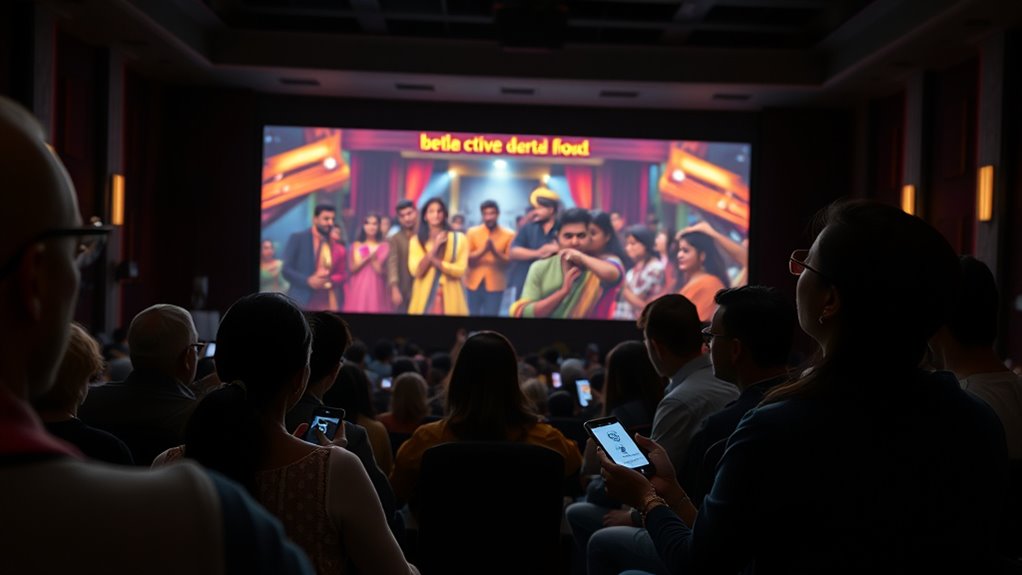
Are audiences ready to embrace interactive movies? The data suggests they are. Younger viewers, especially those aged 15-29, are more open to exploring new content formats and prefer streaming platforms. They actively watch OTT releases, are comfortable with multi-platform viewing, and enjoy genres like comedy, action, and thrillers—all of which lend themselves to interactive storytelling. The shift toward home-based, on-demand content indicates a readiness to try engaging, choice-driven experiences. Despite a decline in theatre visits, a significant portion of urban Indians still visit cinemas, showing they appreciate both traditional and innovative formats. Overall, the younger demographic’s enthusiasm for diverse content and digital consumption strongly hints at a growing acceptance and curiosity for interactive movies.
Opportunities for Collaboration and Innovation in Bollywood
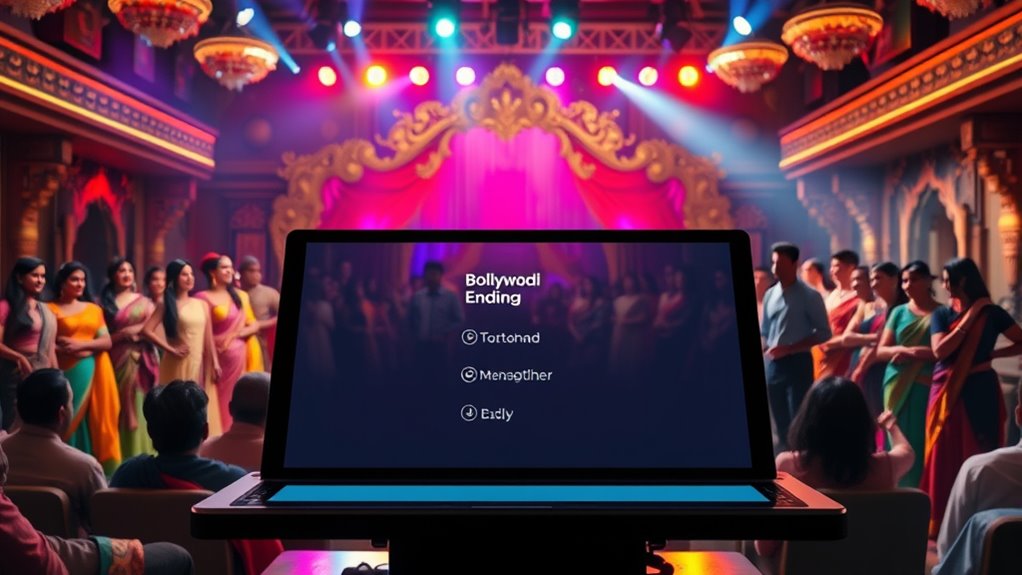
You have the chance to explore international tech partnerships that bring cutting-edge AI and VFX tools into Bollywood productions. Collaborating with global creative hubs can spark new storytelling approaches and innovative visual experiences. By investing in these collaborations, you can help shape a future where Bollywood leads in interactive and immersive cinema.
International Tech Partnerships
International tech partnerships offer Bollywood a unique opportunity to innovate and expand through global collaboration. The strengthening ties between the US and India open avenues for joint projects in AI, VR, and AR, which can revolutionize interactive storytelling. The UK-India partnership aims to deregulate barriers, making cross-border collaborations smoother. These alliances promote technological exchange, enabling Bollywood to leverage cutting-edge innovations and enhance viewer experiences. Global conferences like WAVES encourage international cooperation, fostering fresh ideas and cultural exchange. Cloud computing and 5G networks support seamless data sharing and high-bandwidth applications, essential for interactive movies. By embracing these partnerships, Bollywood can attract foreign investments, create new jobs, and expand its global reach—offering audiences immersive, culturally diverse experiences while opening new revenue streams.
Creative Innovation Hubs
Bollywood is increasingly exploring the development of Creative Innovation Hubs to foster collaboration and spark new ideas within the industry. These hubs bring together diverse sectors like film, animation, games, and music, creating fertile ground for innovation. By establishing joint ventures with countries like Indonesia, you can leverage cultural ties to expand creative exchanges. Digital platforms such as online courses, industry conferences, and international workshops provide accessible tools to develop talent and introduce fresh storytelling techniques. These hubs also encourage industry diversification, with companies from outside sectors entering Bollywood. Collaboration with global partners and co-productions help incorporate new technologies and perspectives. Upgraded studios, advanced visual effects facilities, and cutting-edge digital infrastructure support this growth, positioning Bollywood to push boundaries and experiment with interactive, immersive storytelling formats.
Developing Infrastructure and Skills for Interactive Filmmaking
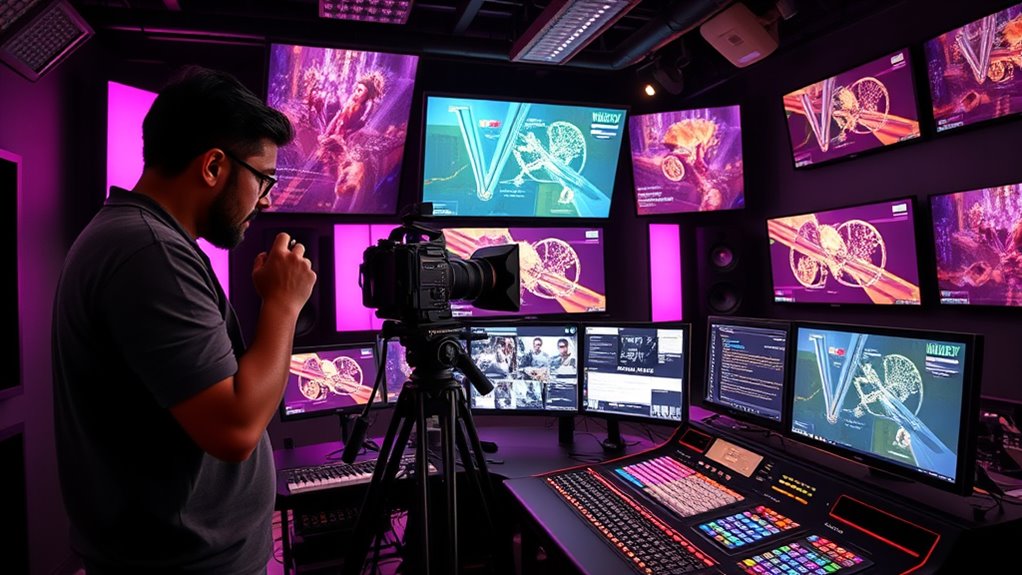
Developing infrastructure and skills for interactive filmmaking requires a strategic focus on adopting advanced technologies and cultivating specialized talent. You need to invest in modern tools like generative AI, VR, and AR, which enhance storytelling and audience engagement. Digital platforms such as Netflix and Amazon Prime are already paving the way by offering interactive content, encouraging growth in this space. To support this, companies like Shemaroo are upgrading storage solutions, while Reliance invests in predictive analytics. Building these capabilities involves training programs, workshops, and collaborations with tech experts to develop creative talent skilled in interactive narratives.
| Infrastructure Focus | Skill Development |
|---|---|
| Advanced storage solutions | Interactive storytelling courses |
| AI and automation tools | Tech-collaboration training |
| VR/AR equipment | Industry workshops |
| Content management systems | Creative talent nurturing |
| Investment in innovation | Specialized training programs |
Consumer Engagement and Cultural Impact of Interactive Movies

As interactive filmmaking continues to evolve, understanding how audiences engage with these experiences becomes increasingly important. You, as a viewer, participate on multiple levels—emotionally, through opinions and feelings, and interactively, via comments, shares, and likes. Platforms track these actions to measure engagement, combining personal reactions and social interactions to gauge overall interest. When movies receive high ratings, it’s often because of this synergy. Indian audiences are shifting from passive watching to more active involvement, especially with streaming and pay-per-view models. Interactive movies deepen your connection to the story, prompting online discussions and community sharing. They also reflect cultural nuances, requiring localization and adaptation to Indian storytelling traditions. Ultimately, your engagement influences content development, making interactive movies a powerful tool for cultural exchange and entertainment.
Pilot Projects and Case Studies From International Markets
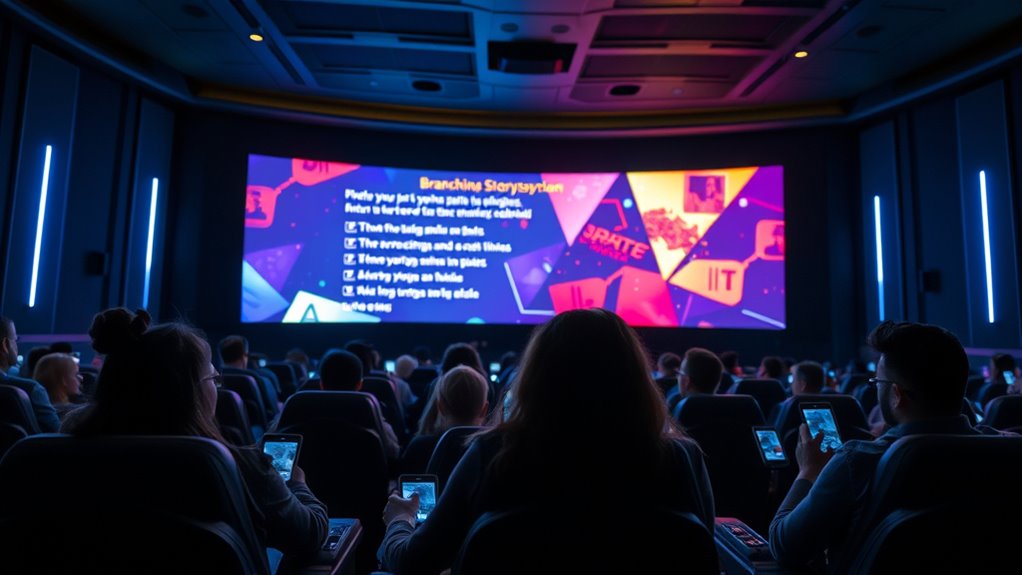
International markets have pioneered innovative pilot projects and case studies that showcase the potential of interactive movies. Netflix’s “Black Mirror: Bandersnatch” is a prime example, letting viewers choose their story paths and endings. The film used mechanics similar to “Choose Your Own Adventure” books, boosting replay value and engagement. However, it faced technical challenges and mixed reactions—some appreciated the novelty, others found it restrictive.
| Project | Features | Audience Response |
|---|---|---|
| “Bandersnatch” | Multiple story paths, branching endings | Mixed, some loved, some found limiting |
| “Antique Trap” | Gamified, interactive interfaces | Limited uptake, engaging experience |
| Bilibili Interactive Videos | Community-driven, user-uploaded content | Growing but niche market |
| “Young Love Type” | Gamified storytelling | Experimental, niche appeal |
| Cinema Audience Voting | Real-time decision-making | Emerging, uncertain success |
Future Outlook: Bridging Creativity and Technology in Bollywood
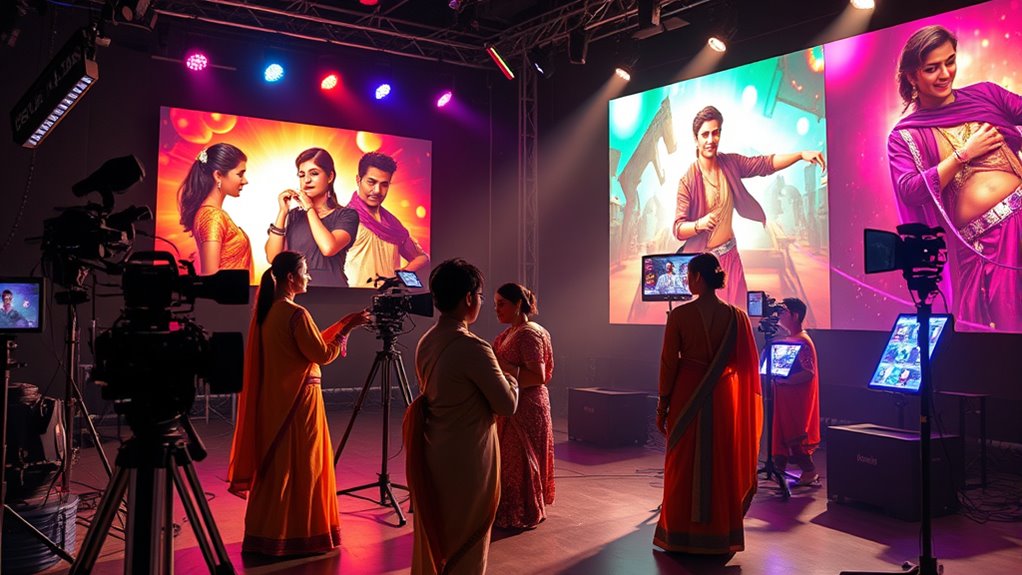
Innovative pilot projects have showcased how interactive elements can transform storytelling, and Bollywood stands poised to harness this potential. Advances in AI, such as enhanced visual effects, motion capture, and real-time virtual production, are already elevating cinematic quality. VR technology, exemplified by films like “Brahmastra,” creates immersive viewing experiences that blend technology with tradition. These tools enable filmmakers to craft richer narratives, preserve cultural elements, and push creative boundaries. As the industry develops skills in AI and CGI, costs will decrease, making advanced tech more accessible. With consumer demand for high-quality visuals and immersive content growing, Bollywood can leverage these innovations to create truly interactive movies, bridging the gap between cutting-edge technology and storytelling artistry. The future promises a new era of dynamic, engaging cinema.
Frequently Asked Questions
How Receptive Are Bollywood Audiences to Interactive Movie Formats?
You’re curious about how receptive Bollywood audiences are to interactive movies. Given the growing digital engagement, rising online gaming, and popularity of social media, audiences are increasingly open to interactive entertainment. They’re already comfortable with diverse formats and real-time participation. While traditional storytelling dominates, the tech infrastructure and streaming platforms provide opportunities to introduce interactive elements gradually, making viewers more willing to embrace choice-driven narratives over time.
What Specific Technological Advancements Are Needed for Bollywood to Adopt Interactive Films?
Did you know that 65% of Indian internet users access high-speed connections? To adopt interactive films, Bollywood needs advancements like widespread high-speed internet, immersive VR and AR tech, and robust digital platforms. You’ll also see the need for secure distribution, real-time audience feedback tools, and collaborative storytelling software. These innovations will make interactive movies accessible and engaging, giving you more control over how stories unfold on screen.
Can Interactive Movies Be Financially Sustainable Within Bollywood’s Current Budget Models?
You wonder if interactive movies can fit into Bollywood’s current budgets. Given high star fees, production costs, and marketing expenses, adding interactivity could strain finances. However, if these films boost audience engagement and revenue, they might become sustainable. You need to contemplate the technology costs and audience acceptance, but with strategic investment, interactive movies could complement Bollywood’s existing financial model and open new revenue streams.
How Could Bollywood Integrate Traditional Storytelling With Interactive Elements Effectively?
You can effectively blend traditional storytelling with interactive elements by respecting Bollywood’s rich cultural themes while incorporating modern tech. Use familiar narratives, songs, and emotions, then add decision points that let viewers influence the story. Keep the experience engaging without overwhelming the audience. Collaborate with tech experts to guarantee smooth execution, balancing storytelling depth with interactive features, so your film remains authentic and appealing to both traditional and modern viewers.
What Successful International Interactive Film Projects Could Serve as Models for Bollywood?
Did you know that projects like Netflix’s *Black Mirror: Bandersnatch* and Telltale’s *Minecraft: Story Mode* set global standards for interactive storytelling? You can learn from their success by adopting multi-platform approaches, involving real-time audience choices, and blending cinematic quality with user engagement. These projects show that with the right technology and storytelling, Bollywood can create immersive experiences, attracting wider audiences and transforming traditional narratives into dynamic, participatory adventures.
Conclusion
Imagine a world where Bollywood films let you choose the ending—over 80% of viewers worldwide now crave more interactive experiences. While hurdles exist in technology and tradition, the potential to revolutionize storytelling is huge. You might soon see movies that adapt to your choices, making each viewing uniquely yours. It’s an exciting future, blending creativity with innovation, and it’s just a matter of time before Bollywood embraces this new chapter in storytelling.

